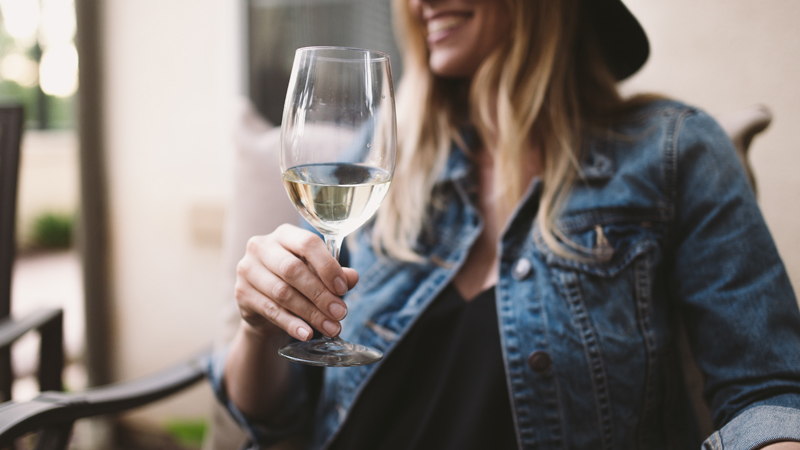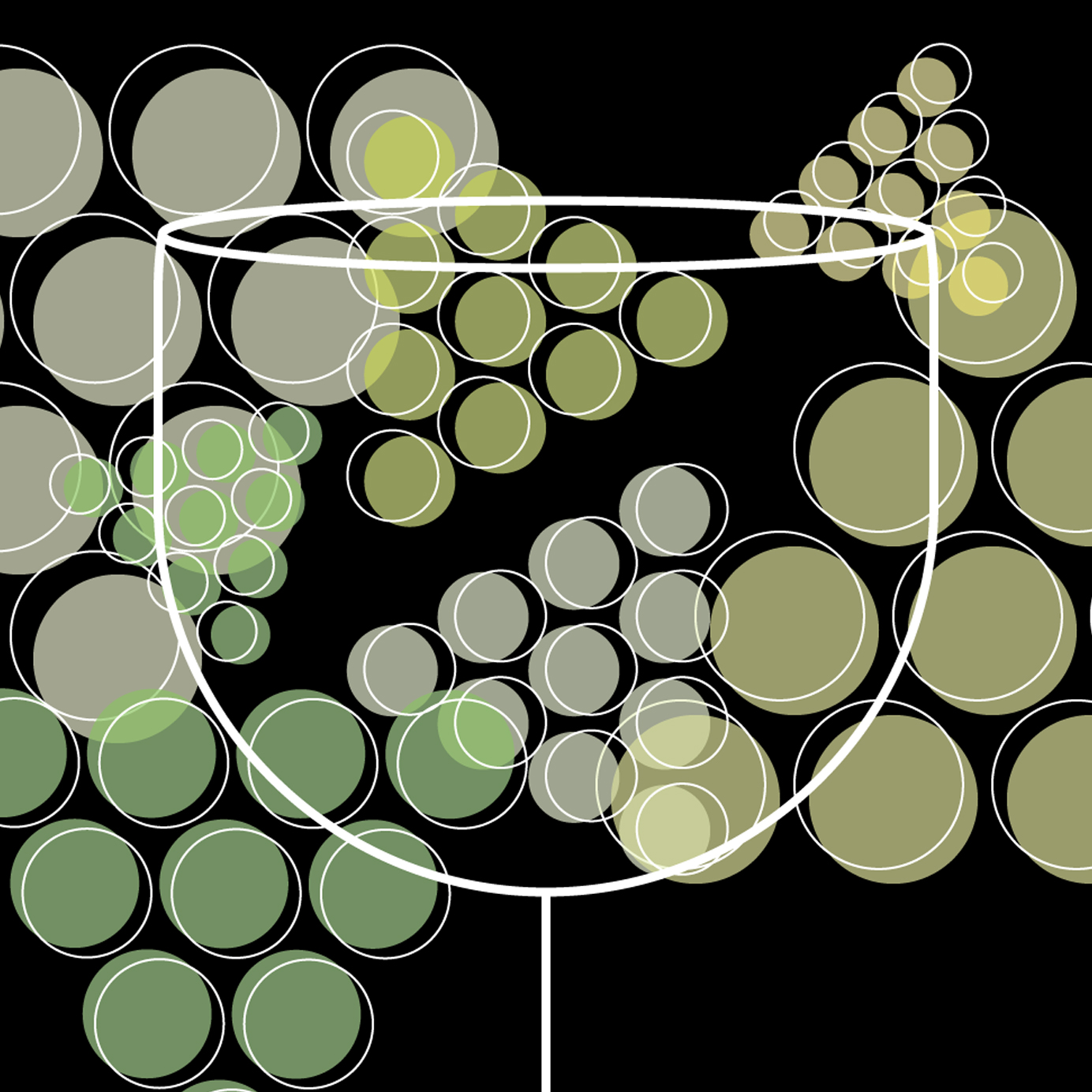“White blends are not as talked about as many other styles,” Mary Gorman, Master of Wine, says. “And that’s a great shame.”
They can be pretty hard to come by, too. Wine-Searcher.com lists just four recognized white blends among its 61 dry white categories (the rest are varietal wines). Red blends, on the other hand, are an established category. Wine-Searcher lists nearly 20 red blends, ranging from Bordeaux’s oft-imitated combination of Cabernet Sauvignon, Merlot, and Cabernet Franc, to California’s chart-topping The Prisoner.
Not only are we not talking about white blends, we’re not buying or making a great deal of them, either. According to Nielsen data, both domestic and international white blends accounted for just 1.7 percent of U.S. wine sales in 2017. White varietal wines like Pinot Grigio enjoyed a 9 percent market share. Chardonnay led the way with an 18.5 percent slice of the pie — more than any other wine.
When it came to reds, the gulf between varietals and blends was nowhere near as wide. Cabernet Sauvignon, the most popular red wine in the U.S., had a 16.9 percent total market share. Red blends clocked in at 12.3 percent.
So why the big divide? You can point to production, of course, and say that fewer white blends are made so fewer are being bought and sold; but there must be a reason for that. Is it that winemakers feel white grapes are happier in their own company or are there bigger forces at play?
Labeling bottles by varietal, rather than region, makes things easier for consumers. Almost all novice drinkers have some experience with Chardonnay or Cabernet Sauvignon, but bottles labeled according to regional appellations like Chablis, or with winemakers’ custom blend names, require additional knowledge to identify and purchase.
This still doesn’t explain why red blends are significantly more common than their white counterparts, though.
One explanation, Gorman says, could have to do with the qualities winemakers seek to develop in white wines.
“Compared to red wines, a lot more white varieties are distinctly aromatic,” she says. The key to making quality wines from these grapes “is preserving those aromas, which blending would otherwise dilute,” Gorman says.
Another consideration comes down to the way we consume whites. We almost always serve them chilled to at least 45 degrees Fahrenheit. Blending, however, produces complex wines that are better enjoyed a few degrees warmer than chilled varietals like Sauvignon Blanc and Pinot Grigio.

White blends are most common in Old World regions, where they face the challenge of being produced in areas that are better known for reds. Bordeaux’s Semillon and Sauvignon Blanc mix is a stunning example of what blending whites can achieve, producing rich, creamy wines, capable of years bottle aging. This white blend accounts for just 3 percent of the region’s production.
The simple reason? The region‘s prestigious red wines command higher prices. According to Wine-Searcher data, just one of the top 10 most expensive Bordeaux wines is a white blend. Four of the top 20 are white blends.
But neither popularity nor price should be taken as an indication of quality. In fact, because of their relative lack of popularity, white blends often offer remarkable value for money. Full of complexity and reliably age-worthy, white blends can be infinitely more interesting than varietal whites, and an economical alternative to premium reds.
If you’re thirsty for something subtle and sophisticated, that’s going to stand the test of time, these three white blends should be on your radar.
White Bordeaux
Though now synonymous with red blends, Bordeaux was predominantly a white-grape-growing region up until the 1970s. The classic white blend is a mixture of Semillon and Sauvignon Blanc, and occasionally includes Muscadelle and Sauvignon Gris.
The blend is produced in a number of appellations throughout Bordeaux in styles ranging from young and fresh to lusciously sweet. It’s finest dry whites come from sub-region Pessac-Leognan, from classified châteaux like Domaine de Chevalier. Chief winemaker Olivier Bernard describes Sauvignon Blanc as the “spinal column” of the Bordeaux white blend, providing structure and acidity. Semillon rounds off the blend, he says, and adds an extra dimension and “charm” with a few years of bottle age.
Pessac-Leognan white blends are luxurious and velvety, characterized by nectarine and sweet baked apple notes. With age, they become richer, developing candied fruit, honey, and custard flavors.
The Semillon-Sauvignon Blanc blend isn’t confined to Bordeaux, however, and features in many New World regions, notably Australia’s Margaret River.
Southern Rhône White Blend
Nowhere is the art of blending taken more seriously than France’s Southern Rhône region. In the fabled Châteauneuf-du-Pape appellation, things are taken to the extreme, with red blends sometimes containing up to 13 different varieties.
The white blends of the Southern Rhône are driven by one of three main varieties, Grenache Blanc, Roussanne, or Viognier, and also include a mix of Marsanne, Ugni Blanc, Clairette, Bourboulenc and Picpoul Blanc. The blend has been copied and adapted in regions worldwide, including Australia, South America, and the United States (particularly California).
One New World producer adopting the style is Paso Robles’ Tablas Creek Vineyard. A joint venture between American wine importer Robert Haas and esteemed Châteauneuf-du-Pape property Château de Beaucastel, Tablas Creek’s vineyards are planted with original Beaucastel clones.
Tablas Creek produces three different white blends, highlighting the different qualities of each of the Rhône’s three leading white grapes. Its Esprit de Tablas Blanc focuses on the “depth and honeyed richness,” of Roussanne, partner and general manager Jason Haas says, producing complex, age-worthy whites.
With its Côtes de Tablas Blanc, “we want to show the more fruity, floral, and aromatic characteristics of the Rhône,” he says. Viognier leads the way, providing floral notes and stone fruit character. Marsanne adds elegance, and Grenache Blanc boosts acidity. It’s an easier-drinking blend than the Esprit, Haas says.
The final blend, Patelin de Tablas Blanc, showcases the “vibrancy and acidity” of Grenache Blanc, he says, with smaller quantities of Viognier, Marsanne, and Roussanne adding body.
White Rioja
There are seven varieties permitted in the white Rioja blend, the most common of which are Malvasia and Viura. “Malvasia is more fruity and aromatic,” Gorman says, “whereas Viura brings flesh to the wine.”
Untraditional international varieties like Chardonnay and Sauvignon Blanc are also occasionally included to add “brightness, freshness, and ageability,” Gorman says.
Like Rioja reds, barrel aging and fermentation are important in classifying white Rioja. Age statements start with joven, or less than 15 months old, and go up to gran reserva, which has a 48-month minimum aging period, six months of which take place in the barrel.
Joven white Rioja is refreshingly acidic and citrus-driven. With oak influence and bottle age, the blend becomes bold and aromatic, full of nutty, dried fruit notes and saline minerality.
